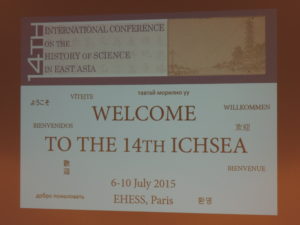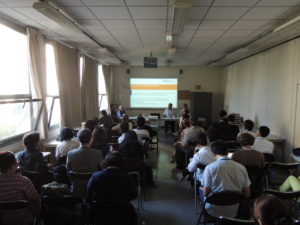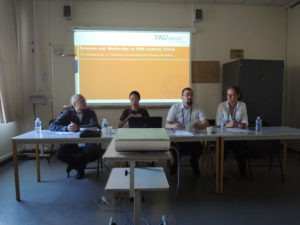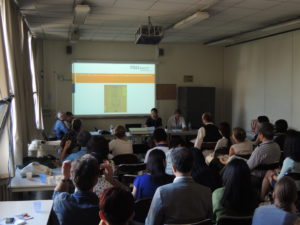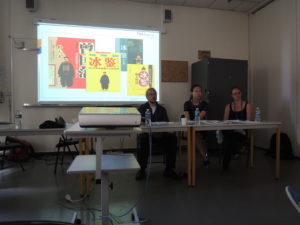Science and Modernity in 20th Century China: The Renaissance of “Traditional Knowledge and Practice” Revisited (14th ICHSEA 2015)
From 6-10 July 2015 the 14th International Conference on the History of Science in East Asia (14th ICHSEA) took place in Paris.
Prof. Marc A. Matten, Dr. Rui Kunze, Song Xiaokun (IKGF) and Renée Krusche took part in this conference:
Science and Modernity in 20th Century China: The Renaissance of “Traditional Knowledge and Practice” Revisited
The aim of this panel is to shed a light on the conceptualization of science in China in the latter half of the 20th century. Existing research of the past has argued that science – primarily conceived as a means to strengthen the country – was supposed to be taken over from the advanced nations in order to imitate the Western model of modernization. This eventually resulted in the judgment that modern sciences cannot but mean “Western science”.
This panel is going to demonstrate that the conceptualization of science after the foundation of the People’s Republic of China experienced a fundamental transformation that questions the universality of Western science. Despite the highly ideological handling of historical materialism in both political and science discourse during the Mao era, the discipline of science (and especially natural science) was rather used pragmatically in modernization, which also led to a renaissance of traditional forms of knowledge both pre- and after 1976.
The papers of this panel analyze several discourses of knowledge and science in the last four decades of the PRC. Focusing on the questions of how scientific knowledge is produced, how it is justified politically and communicated socially the papers intend to show how the renaissance of non-Western knowledge observable today occurred in fact already during the Maoist period, so that the co-existence of traditional forms knowledge such as traditional Chinese medicine, fengshui and mantic practices with the so-called “modern sciences” is not just a phenomenon of the post-Cultural Revolution era.
Promoting Scientific Thinking in Communist China – the conceptualization of science in Maoist China and beyond (Prof. Marc A. Matten)
This paper discusses the strategies and methods of propagating science and scientific thinking in post-1949 China. By focusing on the modernization and introduction of new knowledge I argue that the dissemination of science (kexue puji) was a highly complex process that owed its success to a great deal of creativity in defining and legitimizing both modern and traditional, foreign and indigenous forms of scientific knowledge. This allowed for a greater plurality of acceptable forms of science in Chinese society, which was due to a different epistemology of science. In this paper I analyze the origins of this epistemology, its interaction with the “modern” European/Soviet epistemology of science and the consequences thereof for the process of (capitalist) modernization in 20th century China.
By analyzing reproductions of classical writings on veterinary medicine (most prominently Zhongguo xumushi ziliao 中国畜牧史资料, 1958; Yuan Heng liao ma niu tuo jing quanji 元亨疗马牛驼经全集, 1963), agricultural journals (Agricultural Knowledge 农业知识, 1951-83; Agricultural Technology 农业技术, 1957-68; Agricultural Science Communications 农业科学通讯, 1949-1959), Chinese and Soviet textbooks of veterinary medicine published or translated during the 1950-60s, and finally nation-wide publications focusing on science dissemination (Science and the Masses 科学大众, 1937-50; Science Dissemination Work 科学普及工作, 1951-58; Science Illustrated 科学画报 1933-66) I show that the socio-political process of knowledge production in that era resulted in the creation of different systems of knowledge that both claimed to be scientific, but surprisingly did not contradict each other. Thus, instead of reproducing the problematic dichotomy of West vs. East, or modern vs. tradition, this paper demonstrates other ways of justifying scientific methods and scientific ways of thinking. By doing so it is hoped that the history of science in both East and West will be able to take local practices serious and integrate them into the global process of knowledge production more adequately than before.
Learning from the Masses: Traditional Knowledge in the 1950s and 1960s (Dr. Rui Kunze)
This paper will examine the definition and use of „traditional knowledge“ in 1950s and 1960s People’s Republic of China (PRC). While following the Soviet model to imagine its future of communist modernity, the PRC witnessed a surge of sorting out and promoting knowledge such as traditional Chinese medicine, Qigong, Chinese ceramic and silk manufacturing crafts, etc. in the 1950s and 1960s. This paper looks at the case of the development of the Eight-Character Policy of Agriculture (農業八字憲法) at the end of the 1950s and its dissemination in the 1960s within this context. In this case, old farmer sayings – a form of traditional knowledge from the masses – were promoted and integrated into the official agricultural policy in order to develop a modern, scientific agriculture. By looking at a variety of primary sources – the major newspapers (e.g.人民日報) , popular science magazines (《科學大眾》《科學畫報》, 《農業知識》, etc.), school textbooks for general science education (《自然》,《常識》and 教學參考資料,《上海市農業中學, 農業八字憲法教學參考資料》), science documentaries (e.g.《水》,1961), and a series of pamphlets and books(《八字憲法的農諺解說》《正確貫徹農業“八字憲法”》, etc.), this paper examines the case in view of the notions of „practice“ (實踐) and „experiment“ (試驗) in Mao Zedong’s writings and proposes to understand the case as an example of negotiating between indigenous knowledge and modern (presumably universal) science out of the following three reasons: 1) the practical concerns of financial, natural, and human resources; 2) the need to bridge the epistemological gaps between the urban and the rural, the educated and the illiterate; 3) the ideological necessities of emphasizing the Chinese identity to cement nationalism in a hostile global context and of demonstrating the goal of realizing a classless society.
Redefining Fengshui: Academic Discourses in the PRC from the 1990s to the Present Day (Song Xiaokun)
Since the late 1980s and the early 1990s, Fengshui has been a research subject in Chinese universities. Initiated by scholars in departments of architecture, discussions of Fengshui appear now within many disciplines in the Chinese humanities and social sciences. However, this development has a side effect: Fengshui must be made compatible with science in order to be suitable for academic research.
My paper introduces the academic discourse on Fengshui in the PRC since the 1990s. It aims to show two points: (1) How the Chinese scholars’ views on this subject have been influenced both by the Western understanding of Fengshui (“New Age”, environmental movements, etc.) and by the Western understanding of Chinese science (e.g., Needham’s concept of Chinese science and especially his view of Fengshui). Since different disciplines have particular positions and approaches towards Fengshui, my analysis will focus on the views of three scholars who belong to different disciplines: Prof. Wang Qiheng 王其亨 (architecture), Prof. Yu Xixian 于希贤 (geography) and Prof. Wang Yude 王玉德 (history). (2) How, based on the modern understanding of Fengshui, Chinese scholars attempt to “redefine” and even “recreate” Fengshui, in order to integrate it into the academic disciplines and to support their discourses on the history of Chinese science. For this purpose, my paper will present a case study concerned with the attempt to establish a new discipline, namely, “Architectural Fengshui” 建筑风水.
Traditional Chinese Veterinary Medicine inMaoist China – Horse Health Care between 1949 and 1966 (Renée Krusche)
This paper will discuss the development of Traditional Chinese Veterinary Medicine (TCVM) during the first two decades of the PRC and the extent to which TCVM was used for the treatment of horses. It will show how TCVM was defined and established as a science just like Western medicine through the founding of institutions and an educational system as well as the distribution of knowledge, such as via scientific papers, research projects and efforts of state-sponsored science dissemination. In this context the paper will talk about Mao’s idea of creating a “new (veterinarian) medicine” 新式中(兽)医 by combining TCVM and Western medicine, thus creating a new system of knowledge that was meant to help the Chinese farmers to cure animal diseases and improve animal husbandry. By focusing on some explicit examples of the treatment methods used for horse diseases I will show how TCVM practitioners and veterinarians chose and implemented their preferred methods of treatment, and analyze what impact their choices had on the definition of the scientific character of veterinary medicine.
